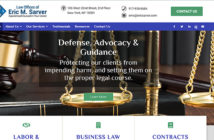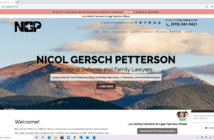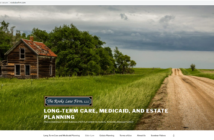Blogging is this Baltimore lawyer’s number-one source of business. Speaking, initially before small local groups, is second. And his non-law affiliate is a major source of work.
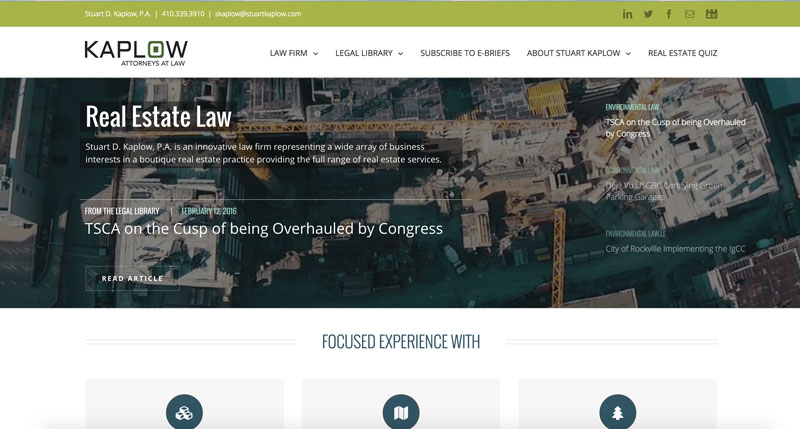
Stuart Kaplow has been a solo practitioner in Baltimore concentrating on real estate law for 30 years. He started out as a generalist, and over the years slowly shifted toward a focus on helping clients facing land use-related environmental issues.
His career trajectory took a sharp turn a decade ago when he climbed Mount Kilimanjaro, saw the curvature of the earth and the thin layers of the atmosphere, and realized how fragile it all was. Upon his return from that trip, he says, “I shifted the practice almost exclusively to what is now known as sustainability and green-building law. When I did that in 2005, most of my clients shook their head and said, what are you thinking? ‘Sustainability’ was not a word generally associated with legal issues at the time, and the term ‘green building’ was just coming into use, so it was a very modest niche.”
The area of law has grown considerably since then. It is now large enough to support a thriving practice for Kaplow helping users of property navigate the expanding body of environmental zoning laws and regulations, and green building codes. He became a go-to lawyer in the field by writing prolifically on the subject and speaking before any trade group with an interest in what he had to say. The appearances led to appointments to groups including the U.S. Green Building Council, a zoning law advisory committee and the Baltimore City Brownfields Working Group. The stints in public service haven’t led directly to new business for his law practice but have made him all the more visible in the field.
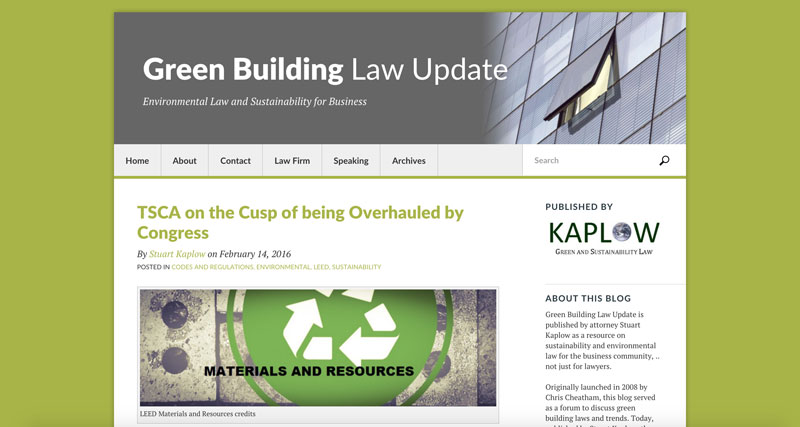
Making a Mark with Prolific Writing
Kaplow started making a name for himself as a green-building lawyer by writing for outlets that he created. “There weren’t even journals in the field when I started this,” he explains. “So at first, I wrote articles and published them in a newsletter that I sent to people through the U.S. mail, which seems ancient today when I have a very widely read green building blog. I also publish articles on my website, and I still do a newsletter by email, so I have three places where I publish variations of articles,” Kaplow says.
“I have also written for the publications of builder and developer trade associations, home builder and office building groups and allied organizations. And I’ve written two scholarly law review articles since I’ve been in the practice. My first law review article, “Does a Green Building Need a Green Lease,” was one of the first law review articles in the United States on green buildings and it was widely republished and cited. When I look back at it I am horrified by the article. It was pretty rough. But in its day, there were not a lot of other law review articles out there on the state of green building law, because it was in its infancy.”
The main forum for his writing these days is the Green Building Law Update, which he has published since 2008. In all that time, Kaplow has maintained a commitment to posting something new at least once a week, a key to building and keeping readership.
Asked if that’s a burden, he responds without hesitation, “Not at all. It keeps me sharp. This is a fast-evolving body of law and the blog causes me to stay current on a whole host of topics. My posts very often are related to cases I’m working on, but it really causes me to look at issues a little more broadly than I might just to deal with an individual client issue.”
Kaplow got a head-start with his blog by taking it over from its founder, Chris Cheatham. “He believed in green buildings but it just was not something that was lucrative for him so he was moving on to another field. He reached out to me and I agreed to take it over. It had a modest readership, which had dropped off because he had not been posting very often. But he had over 500 regular weekly views on the blog, and it was well respected by key thought leaders in the green building world, and that is why I was interested.” Kaplow acquired it for “a very modest sum. I can assure you, he did not turn it over to me for the money. His concern was that it be taken over by someone who believed in green building law.” Traffic to the blog has grown “more than ten-fold” since he has been publishing it, Kaplow says.
He gets extra mileage from his blog posts by recasting them for other outlets, including his own e-mail newsletter, which he continues to publish about 10 times a year. “Very often I write three different versions of an article,” he says. “If I write a blog post that would have some general interest but would also be of interest to a trade association, I will offer a variation of it for one of their publications. Then I might do a Maryland-centric version for my newsletter.”
His prolific writing “definitely brings in business,” sometimes for years after a post first went up, Kaplow says. “I wrote an article some years ago about common errors in real estate contracts. To this day, it generates on average two telephone calls a week.”
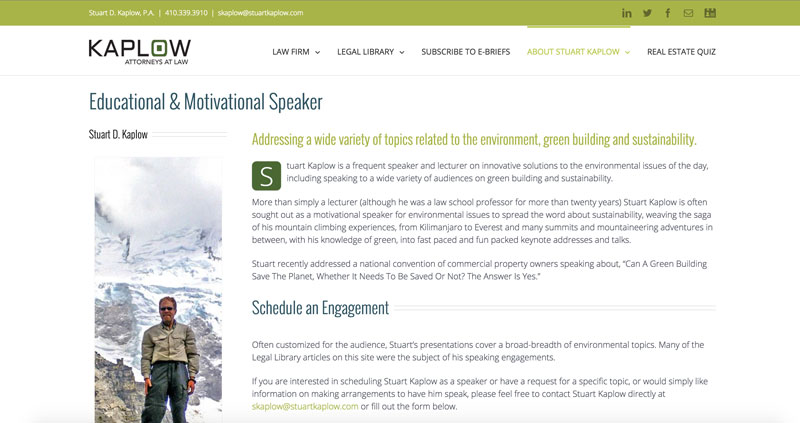
Second Prong: Public Speaking
The “second prong” in his approach to rebranding himself, and an ongoing generator of business for his firm, is public speaking, at events ranging from local chapter luncheons to national conventions, Kaplow says. “People laugh at me when I go to the Snow and Ice Management Association annual convention, but that room is full of people who might want to engage a lawyer to assist them in making snow and ice removal sustainable,” he says. “I go to the Asphalt Paving Association Convention because they are concerned about environmental issues. Speaking at those types of events has been the key to developing my practice in this niche.”
His speeches are in part “motivational” and about environmental imperatives. He usually finds ways to work in stories about his mountaineering adventures around the world, and in his powerpoint presentations, he works in slides he took along the way from the Khumba ice fall on Everest to Kilimanjaro.
“I am fortunate that I now get invited to the big winter conventions in Florida and the summer conventions in Colorado and Montana. But a number of years ago, I started speaking about green buildings to some pretty small groups, let me tell you. But that’s okay, because you can both hone your speaking skills and demonstrate your proficiency. Also, much of the practice of law is still local. Most lawyers are licensed in a single state and practice only in that state. So speaking at a local homebuilders event or at any local trade association event is a great way to promote your practice,” Kaplow says. “Many groups meet monthly or bimonthly and they are often looking for a speaker. The ability to speak to a local business group, even if you get only a dozen business people in a room, can be a wonderful marketing opportunity if it’s the right dozen people.”
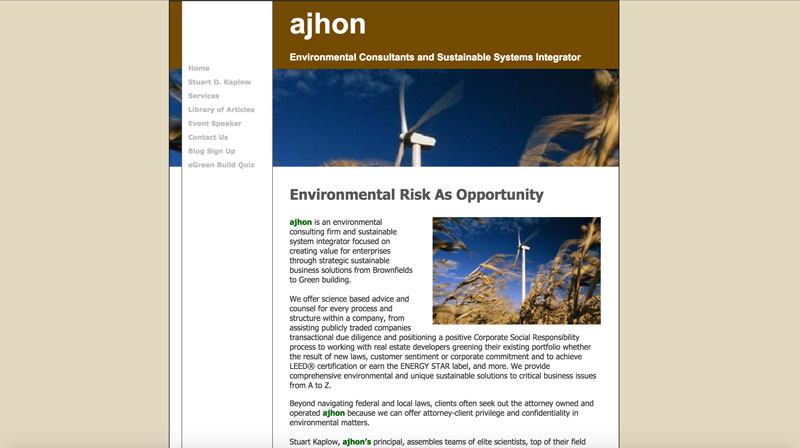
Non-Law Affiliate Widens Reach
For more than 20 years, Kaplow has complemented his law practice by offering environmental consulting services though a non-law subsidiary called ajhon, which means “green” in the language of the Maasai tribe of east Africa.
He started the consulting firm in 1994 in response to his clients’ needs for non-legal environmental services. Many of the largest law firms in the nation have non-law subsidiaries offering accounting, economic analysis, lobbying, medical consulting, and other services. “It is not common for a solo practitioner to do this but it should be. It is a significant piece of our business,” says Kaplow, who estimates that as much half of his work these days is generated by the non-law affiliate.
In both his solo law practice and the affiliate, he leverages his own expertise with an assembled team of other professional including attorneys, engineers, and scientists who either have specialized expertise in a subject area or are geographically proximate to projects.
“The consulting firm’s work involves everything from water-use reduction to reduction in energy use to a whole host of green building and other environmental issues. It allows us to offer turnkey environmental services that go beyond the limited piece of it that is traditional legal work and address the entire issue for a client from A to Z. We can give science-based advice about literally every process and structure that a business has.”
Having both the law firm and the non-law affiliate has significantly increased the array of clients he can serve. “It is difficult for many large businesses to retain new and different outside counsel,” Kaplow explains. “It is much easier for them to retain a new consultant. There are a lot of Fortune 1000 businesses that we work for that might not hire us to do their legal work, but hiring us as an environmental consultant is a much easier task for them. It also allows us to work in geographic areas where we might not have a licensed attorney, particularly since much of the work that we do is not traditional legal work.”
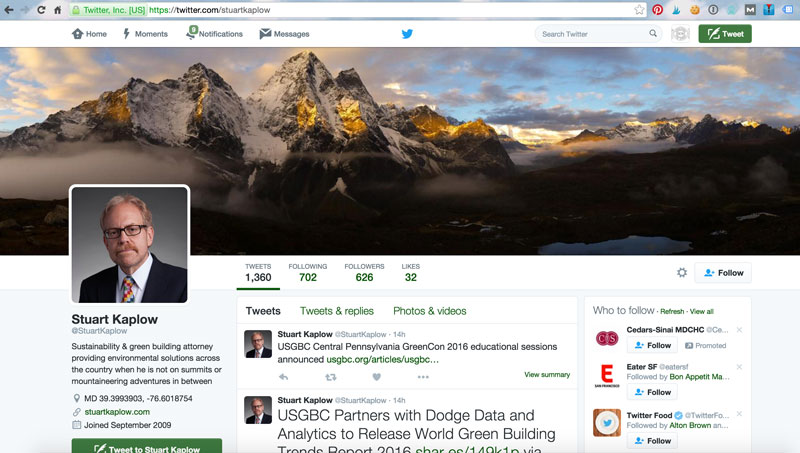
Nothing Beats Blogging
Kaplow makes limited use of social media, largely because the other methods he has used to generate business have been so successful. He has an active Twitter account where he tweets about his own articles, court rulings, and other sustainable building news. He also has a Facebook page, but doesn’t have time to keep that fresh. “There are only so many hours in a week, and I know that I always want to generate an article each week. That is my number one marketing priority each week,” he says.
For more than 20 years, Kaplow taught a real estate transactions course as an adjunct professor at the University of Baltimore School of Law, a job he dropped when his workload got too heavy. “If I could find time in my schedule I would still be doing it. Nothing keeps you sharper than a room full of bright young law students asking questions,” he says. From a marketing standpoint, it is “yet another way of establishing credibility in the field by teaching what you do.”
But nothing has worked better for him than blogging, Kaplow says. “My number one advice about marketing for any lawyer is: Start writing a blog. Don’t think about it. Just start writing. Because you’re going to write about an area of law that presumably you’re interested in and want to practice in, it generally should be near effortless. The opportunity to write for other publications, speaking opportunities … all that can flow from a blog.”

